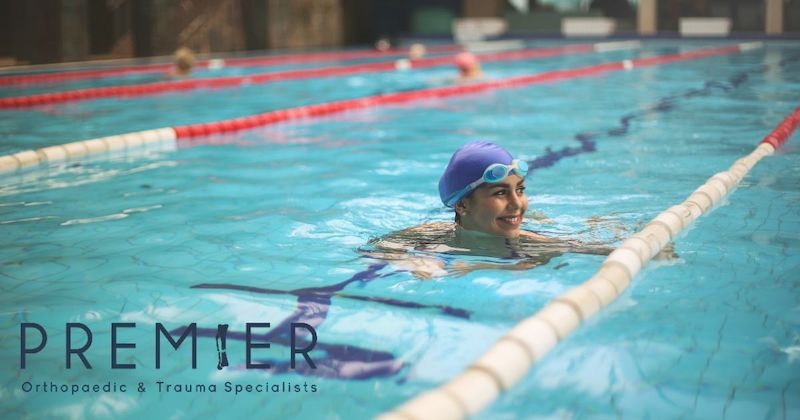Swimming – Spotlight on Great Orthopedic Exercises

Whether you have experienced orthopedic injury or not, performing regular, low impact exercises is critical to maintaining muscle mass, bone health and ultimately avoiding overuse and long-term impact injuries. One of the best exercises to achieve this is simply swimming.
Swimming combines the benefits of cardio and strength training and provides a complete, head to toe workout while minimizing the risk of impact related injury to the joints and soft tissue. This can lead to losing weight in the troubling spots and strengthening the CORE and arms, which we all like. Further, swimming, especially outside, exposes us to fresh air and vitamin D from the sun both of which can improve mood. Impressively, Vitamin D can improve the absorption of calcium and help with bone density loss as we age. As a result, recovery from most injuries can include swimming or water-based exercises, once cleared by your orthopedic surgeon.
However, while swimming is truly an excellent way to stay healthy and/or recover from an orthopedic injury, it also comes with some caveats and considerations.
Considerations to Be Aware Of
While swimming itself is effective and generally non-injurious, poor form is not. For example, many people want to quickly ramp up their exercise duration and intensity as they start to see results from swimming. Typically, they begin to perform the front crawl – the speediest and most intense of the standard swimming strokes. However, in many cases, patient do not kick hard enough which allows their lower body to sink and forces the shoulders to do all their work. This, of course, can lead to shoulder injury and ultimately the abandonment of the swimming program entirely.
It’s also important to remember that submerging your body in water reduces body temperature which can lead to hunger. Consuming food is one way the body fires up its internal furnace to normalize its internal temperature. However, giving into this craving means extra calories that can quickly lead to offsetting any gains made by the exercise. As we know, even small amounts of excess weight can put significant pressure on the joints throughout the body.
Lastly, it is important that you change up your routine. So, while swimming is excellent exercise it shouldn’t be your only exercise. The monotony of performing the same exercise over and over again he’s not only difficult to maintain from a psychological point of view, but muscles become accustomed to the work out and it becomes less efficient. Try adding other exercises as per your post-procedure/post-injury guidelines.
The Bottom Line
After an orthopedic injury, whether requiring surgery or not, swimming can be a great way to build muscle, improve range of motion, lose weight and recover more efficiently and fully. However, do speak to your orthopedic surgeon to understand more about the dos and don’ts of swimming and to get proper guidance and clearance on when you can begin to swim again during the recovery.


 ES
ES